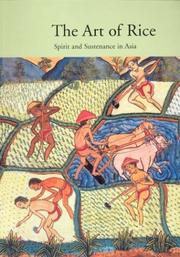| Listing 1 - 5 of 5 |
Sort by
|
Book
ISBN: 9782873730260 Year: 2011 Publisher: Bruxelles ISELP
Abstract | Keywords | Export | Availability | Bookmark
 Loading...
Loading...Choose an application
- Reference Manager
- EndNote
- RefWorks (Direct export to RefWorks)
Sculpture --- sculpture [visual works] --- installations [visual works] --- video art --- red [color] --- skulls [skeleton components] --- blown glass --- Oryza [genus] --- water [inorganic material] --- bone [material] --- thread --- Dervaux, Laurence
Book
ISBN: 8480263121 Year: 2007 Publisher: Madrid Museo Nacional Centro de Arte Reina Sofia
Abstract | Keywords | Export | Availability | Bookmark
 Loading...
Loading...Choose an application
- Reference Manager
- EndNote
- RefWorks (Direct export to RefWorks)
Iconography --- Art --- Sculpture --- outdoor sculpture --- installations [visual works] --- abstraction --- pyramids [geometric figures] --- sculpting --- Oryza [genus] --- wood [plant material] --- Laib, Wolfgang --- Germany
Book
Year: 2008 Publisher: Actes Sud
Abstract | Keywords | Export | Availability | Bookmark
 Loading...
Loading...Choose an application
- Reference Manager
- EndNote
- RefWorks (Direct export to RefWorks)
Art styles --- Art --- Sculpture --- Graphic arts --- Photography --- installations [visual works] --- art [discipline] --- Minimal --- motion pictures [visual works] --- pollen --- sculpting --- graphic arts --- Oryza [genus] --- wax --- Laib, Wolfgang --- anno 1900-1999 --- anno 2000-2099 --- Germany
Book
ISBN: 9783037786963 3037786965 Year: 2022 Publisher: Zürich Lars Müller Publishers
Abstract | Keywords | Export | Availability | Bookmark
 Loading...
Loading...Choose an application
- Reference Manager
- EndNote
- RefWorks (Direct export to RefWorks)
Wolfgang Laib's work is characterised by a profound relationship with nature and a declared belief in simplicity. Until today, the artist concentrates on just a few cyclical groups of work. Ever since his journeys to India as a young medical student in the 1970s, Laib is inspired by the notion of seeing humans as part of a larger whole. Having decided to work exclusively as an artist from then on, Laib followed this way of life in his art. The quite power of his interventions asserts itself in his choice of natural materials such as pollen, wax, milk or rice and their use in a very reduced visual language. At Bündner Kunstmuseum, Laib realized a large room-sized installation made of thousands of rice mountains. As an important staple food, rice symbolizes vitality and is fundamental for our earthly existence. The process of creating this work of art is revealed in the book and is related to a conversation between Wolfgang Laib and the architect Peter Zumthor. With this book, Wolfgang Laib reveals the spiritual dimension of art and leads us directly to the sources of his poetics.
Art --- installations [visual works] --- environments [sculpture] --- biological material --- Oryza [genus] --- Laib, Wolfgang --- Kunst en spiritualiteit --- Performances ; installaties --- Beeldende kunst ; Duitsland ; 21ste eeuw --- Zumthor, Peter °1943 (°Bazel, Zwitserland) --- Laib, Wolfgang °1950 (°Metzingen, Duitsland) --- 7.07 --- Kunstenaars met verschillende disciplines, niet traditioneel klasseerbare, conceptuele kunstenaars A-Z


ISBN: 0930741986 Year: 2003 Publisher: Los Angeles UCLA Fowler Museum of Cultural History
Abstract | Keywords | Export | Availability | Bookmark
 Loading...
Loading...Choose an application
- Reference Manager
- EndNote
- RefWorks (Direct export to RefWorks)
The term Asia is a problematic and highly artificial construct as hardly anything—language, religion, politics, or even geography—unites this huge area. Within the context of this study, however—which focuses on parts of South, Southeast, and East Asia (home to the vast majority of the population)—there exists a unifying factor of paramount significance, and that is rice. Not only is rice the staple food in these regions, it is the focal point of a pervasive set of interrelated beliefs and practices. For those who consume it, this foodstuff is considered divinely given and is felt to sustain them in a special way, one that may be understood as constitutional and even spiritual. This volume explores beliefs and practices relating to rice as they are made manifest in the unique arts and material cultures of the various peoples considered. Incorporating essays by twenty-seven authors representing a wide variety of cultures and writing from diverse perspectives, the book is astounding in its multivocality. The thirty-five lavishly illustrated essays describe rice-related rituals and beliefs in parts of Thailand, Nepal, India, Indonesia, the Philippines, Vietnam, Japan, China, and Korea. Throughout, the juxtaposition of magnificent photographs of works of art—paintings, prints, ceramics, textiles, lacquerware, and sculpture—with objects of a more humble nature—agricultural implements, rice-straw ornaments, cooking utensils, baskets, puppets, votive plaques, and so forth—serves to indicate the striking pervasiveness of rice in all aspects and all walks of life. Wedding ceremonies, parades, festivals, celebrations of birth, rites held to honor the rice goddess, and those performed to insure success at every step in the rice-growing cycle are vividly described and illustrated with striking field photographs. The whole gives the reader the rare opportunity to compare the similarities and the differences with which a rich array of Asian cultures view the food that nourishes them.
Art --- History of civilization --- woodcuts [prints] --- Edo [Japanese period] --- cremation urns --- shadow theater --- Oryza [genus] --- gods [deities] --- goddesses --- rural life --- Asian --- Han [Chinese, culture, style, period] --- Qing [dynastic styles and periods] --- Zen [Japanese Buddhism] --- Philippines --- Bengal --- China --- South Korea --- Japan --- India --- Nepal --- Thailand --- Java --- Bali [island] --- Indonesia --- Vietnam --- Asia
| Listing 1 - 5 of 5 |
Sort by
|

 Search
Search Feedback
Feedback About UniCat
About UniCat  Help
Help News
News